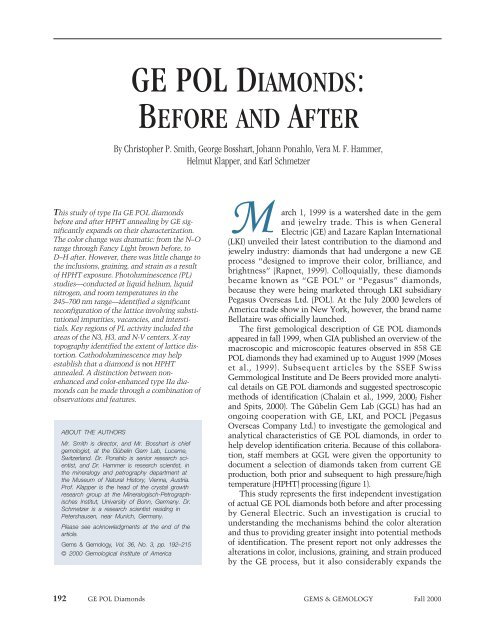Fall 2000 Gems & Gemology - Gemfrance
Fall 2000 Gems & Gemology - Gemfrance
Fall 2000 Gems & Gemology - Gemfrance
You also want an ePaper? Increase the reach of your titles
YUMPU automatically turns print PDFs into web optimized ePapers that Google loves.
GE POL DIAMONDS:<br />
BEFORE AND AFTER<br />
By Christopher P. Smith, George Bosshart, Johann Ponahlo, Vera M. F. Hammer,<br />
Helmut Klapper, and Karl Schmetzer<br />
This study of type IIa GE POL diamonds<br />
before and after HPHT annealing by GE significantly<br />
expands on their characterization.<br />
The color change was dramatic: from the N–O<br />
range through Fancy Light brown before, to<br />
D–H after. However, there was little change to<br />
the inclusions, graining, and strain as a result<br />
of HPHT exposure. Photoluminescence (PL)<br />
studies—conducted at liquid helium, liquid<br />
nitrogen, and room temperatures in the<br />
245–700 nm range—identified a significant<br />
reconfiguration of the lattice involving substitutional<br />
impurities, vacancies, and interstitials.<br />
Key regions of PL activity included the<br />
areas of the N3, H3, and N-V centers. X-ray<br />
topography identified the extent of lattice distortion.<br />
Cathodoluminescence may help<br />
establish that a diamond is not HPHT<br />
annealed. A distinction between nonenhanced<br />
and color-enhanced type IIa diamonds<br />
can be made through a combination of<br />
observations and features.<br />
ABOUT THE AUTHORS<br />
Mr. Smith is director, and Mr. Bosshart is chief<br />
gemologist, at the Gübelin Gem Lab, Lucerne,<br />
Switzerland. Dr. Ponahlo is senior research scientist,<br />
and Dr. Hammer is research scientist, in<br />
the mineralogy and petrography department at<br />
the Museum of Natural History, Vienna, Austria.<br />
Prof. Klapper is the head of the crystal growth<br />
research group at the Mineralogisch-Petrographisches<br />
Institut, University of Bonn, Germany. Dr.<br />
Schmetzer is a research scientist residing in<br />
Petershausen, near Munich, Germany.<br />
Please see acknowledgments at the end of the<br />
article.<br />
<strong>Gems</strong> & <strong>Gemology</strong>, Vol. 36, No. 3, pp. 192–215<br />
© <strong>2000</strong> Gemological Institute of America<br />
M arch 1, 1999 is a watershed date in the gem<br />
and jewelry trade. This is when General<br />
Electric (GE) and Lazare Kaplan International<br />
(LKI) unveiled their latest contribution to the diamond and<br />
jewelry industry: diamonds that had undergone a new GE<br />
process “designed to improve their color, brilliance, and<br />
brightness” (Rapnet, 1999). Colloquially, these diamonds<br />
became known as “GE POL” or “Pegasus” diamonds,<br />
because they were being marketed through LKI subsidiary<br />
Pegasus Overseas Ltd. (POL). At the July <strong>2000</strong> Jewelers of<br />
America trade show in New York, however, the brand name<br />
Bellataire was officially launched.<br />
The first gemological description of GE POL diamonds<br />
appeared in fall 1999, when GIA published an overview of the<br />
macroscopic and microscopic features observed in 858 GE<br />
POL diamonds they had examined up to August 1999 (Moses<br />
et al., 1999). Subsequent articles by the SSEF Swiss<br />
Gemmological Institute and De Beers provided more analytical<br />
details on GE POL diamonds and suggested spectroscopic<br />
methods of identification (Chalain et al., 1999, <strong>2000</strong>; Fisher<br />
and Spits, <strong>2000</strong>). The Gübelin Gem Lab (GGL) has had an<br />
ongoing cooperation with GE, LKI, and POCL (Pegasus<br />
Overseas Company Ltd.) to investigate the gemological and<br />
analytical characteristics of GE POL diamonds, in order to<br />
help develop identification criteria. Because of this collaboration,<br />
staff members at GGL were given the opportunity to<br />
document a selection of diamonds taken from current GE<br />
production, both prior and subsequent to high pressure/high<br />
temperature (HPHT) processing (figure 1).<br />
This study represents the first independent investigation<br />
of actual GE POL diamonds both before and after processing<br />
by General Electric. Such an investigation is crucial to<br />
understanding the mechanisms behind the color alteration<br />
and thus to providing greater insight into potential methods<br />
of identification. The present report not only addresses the<br />
alterations in color, inclusions, graining, and strain produced<br />
by the GE process, but it also considerably expands the<br />
192 GE POL Diamonds GEMS & GEMOLOGY <strong>Fall</strong> <strong>2000</strong>


